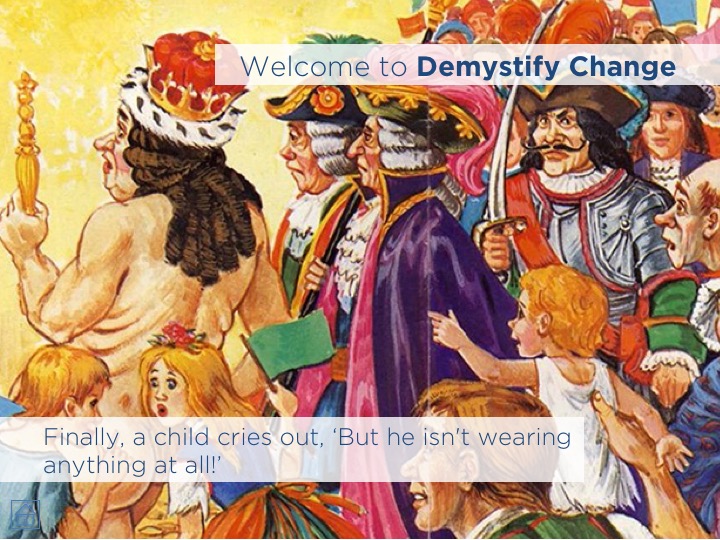Change can’t be an afterthought. Nor can it solely rely on communication and training. Change must be plugged into the heart of an organisation’s delivery approach. It must reflect in its delivery DNA. Here’s how.
 Francesca Valli, Founder and Change Consultant, Chrys Online; francesca@chrys.online
Francesca Valli, Founder and Change Consultant, Chrys Online; francesca@chrys.online
Francesca recently spoke at the Innovation, Business Change & Transformation Conference Europe 2018 this past March on the subject Demystifying Change. View the event gallery here.
The Board is looking to you to make this change happen. They are worried about the competition, an obsolete operating model, ‘burning’ platforms. Change is not an option. You are worried about the progress of your change project. The progress report feels like wishful thinking, indicators ‘green’ but, scratch the surface, and you discover an over-reliance on the need to ‘catch up’ and roadblocks are everywhere.
If this is you, you are right to be worried. This project is failing.
Projects of transformation fail because business change practices are inexistent, governance is weak and the mechanics of the delivery malfunctioning. In this article you will be offered strategies and practices of effective business change delivery that lack the complexity and the fancy practices usually associated with it. We make business change so difficult. It doesn’t need to be. This emperor really has no clothes.
Change in Three.
At Chrys, we are helping organisations change, minus the complexity. Out of the universe of methodologies out there, we have come up with a combination of tools, practices and plans based on our best-case studies and that we have seen work ‘on the ground’, again and again. They are business-focussed and will see you quickly re-pivot a failing project and put it on the path to delivery. There will be wider governance practices and mechanisms for the wider delivery but here we address business change from the perspective of business engagement and business readiness. We call it ‘Change in Three’.
It is these tools, practices and plans that give the business community a voice and create a collaborative, transformational culture. Are these the totality of the tools, practices, plans you need? Well, they are the necessary and sufficient ones. You can do more but you absolutely cannot do less. Here they are.
The Tools.
Geographical scope, legal entity scope, the identification of the impacted business community often remain hazy until late. The impact assessment of the change is conducted with little rigour and, it too, remain hazy until late. And yet the business community is expected to sign off the change and adopt it. By then it’s late: conflict and resistance are to the fore. Our solution? Put these data gathering tools in place to get a clear grasp of scope, build on the existing definition so that all activities have a meaningful continuity and so that the business community can make advised decisions.
These tools are neither mind-blowingly original nor of our exclusive invention. They are easy to set up and operate. They are flexible and can be adapted and scaled up or down to suit your project. This is what they are, and this is their purpose:
• The Change Management Network stakes out geographical and legal entity scope. It leads you to identify the senior leadership you need to communicate with and to identify the members of the business community that must be accountable for chang
• The Impact Assessment ‘plugs’ the change activities, above and beyond training and comms, into the ‘to be’ definition documented by the analysts. The business community must then be given accountability for the resulting actions and actions tracked onto the change plan.
• The Business Readiness Criteria tool encourages the business community to set out criteria which, if met, will facilitate sign off. On the negotiations and debates around meeting these criteria the project team and the business community gather to collaborate. And given the criteria are set up early on, objective closure criteria are established away from the pressure of launch.
The data gathered within these tools form a tangible whole that allows you to have a grasp of the context, the shape and size of the ‘beast’, as it were, to be delivered. Our description ought to help you validate any existing tools you might already have in place to align to our suggested purpose.
The Practices.
Two aspects form the core of healthy business change practices: the first is that of establishing governance to keep track of progress. The second is that of constituting a specific body to operate the tools, participate to governance and deliver the change plan. We are keeping, here, to the practices focussed on the business community working in alignment with the project team. There will be wider governance practices and mechanisms for the wider delivery but here we address business engagement and business readiness.
The governance. There are three parties to this particular marriage: the project team, the ‘mechanism’ for the delivery, the business community, the ultimate ‘adopter’ of change and the change work-stream, whose remit is to bring project team and business community together.
Establish a ‘rhythm’, regular-frequency meetings where these three parties collaborate on an agenda focused on ‘how we track against plans’, rather than ‘what we have done’. And then fix, collaboratively, risk and issues and work towards meeting the readiness criteria and delivering the change plan.
The business community, as represented by a ‘business acceptance group’ is key. Without an engaged business community, no change is landed successfully, no change will ‘stick’.
How do you go about constituting a ‘business acceptance group’?
• Source it from the areas of the organisation impacted by the change. Identify people hungry for doing things better, within the appropriate layer of management.
• Mobilise it, engage it through participation to governance. Make it accountable for the delivery of the activities on the plan.
• Have it participate to the impact assessment, have it set out the business readiness criteria and contribute to build and deliver the change plan.
• Bring the ‘business acceptance group’ and the analysts from the project team together to address risk and issues and meet business readiness criteria.
• Make the ‘business acceptance group’ your friend. Build on their hunger for doing things better as a way to … do things better.
The ways of thinking engendered within these practices and applied over the relatively long duration of the project, bring the transformational thinking the organisation needs. It is these practices and collaborative thinking that turn a ‘business acceptance group’ into an ‘asset’ embedded in the structures of learning of the organisation that will remain in place long after the project is over.
The Plans.
We are struck by how inadequate the plans underpinning the delivery of complex projects often are. Unplanned dependencies, lack of cross-vertical integration across work-streams, un-resourced activities: none is uncommon. Here, we are specifically addressing the change plan.
The change plan focusses on the activities to be carried out within the business operations and by the ‘business acceptance group’. This is the moment to loop back to the tools, dust down the impact assessment and the business readiness criteria and use their data to map out the resulting activities onto the change plan.
How?
• Run an ‘integrated’ planning session with the project team, utilising the data and the insight provided by the tools.
• Assign accountability for actions to named ‘business acceptance group’ members who must take accountability for their delivery.
• Think reasonably in terms of how long activities take, in the real world. Remember ‘contingency’, holidays and, in a global project, country-specific holidays.
• Resource it and cost it. State the underlying assumptions, consider the risk and the issues and state their mitigations.
• At the governance meetings, review the progress against the plan and institute a zero tolerance to delays, unless they come with a substantiated explanation. Address the root cause of delays and roadblocks. Without fail.
These good planning practices will make a difference between a credible plan and a plan that all stakeholders will laugh right off.
At Chrys we believe in demystifying change.
Projects of transformation fail because business change practices are inexistent, governance is weak and the mechanics of the delivery malfunctioning. With our experience in transformation and our belief that we complicate things extra-ordinarily, we encourage you to get the failure out of the way quickly, quickly re-mobilise by putting the suggested tools, practices and plans in place so that you can get on with it. Be the person in your organisation that stands up to failure and turns things around.
To get free templates of the tools we write about and to get business change right for your project, get in touch with Chrys. It’s simple and easy.
Francesca is a connector of people, a talent scout and, above all, a deliverer. She has managed multi-million £ programmes and delivered trackable change aligned with today’s technology. Her past experience in finance and system analysis gives her an edge in understanding and creating change at the organisational level. Part of her success is based on aligning stakeholders to transformation goals. She has founded Chrys to help organisations change. Minus the complexity.
Copyright Francesca Valli, Founder and Change Consultant, Chrys Online


